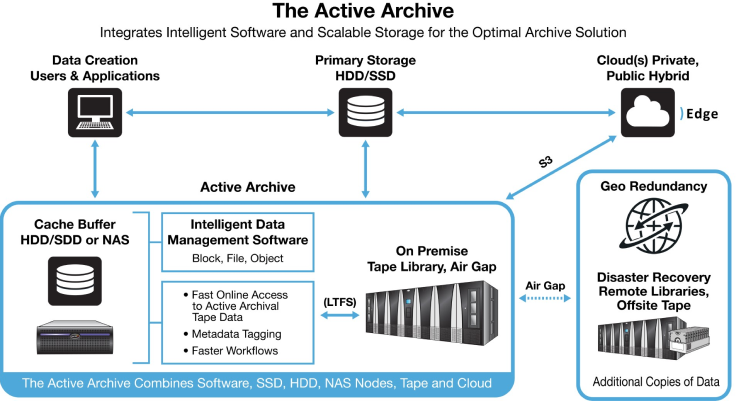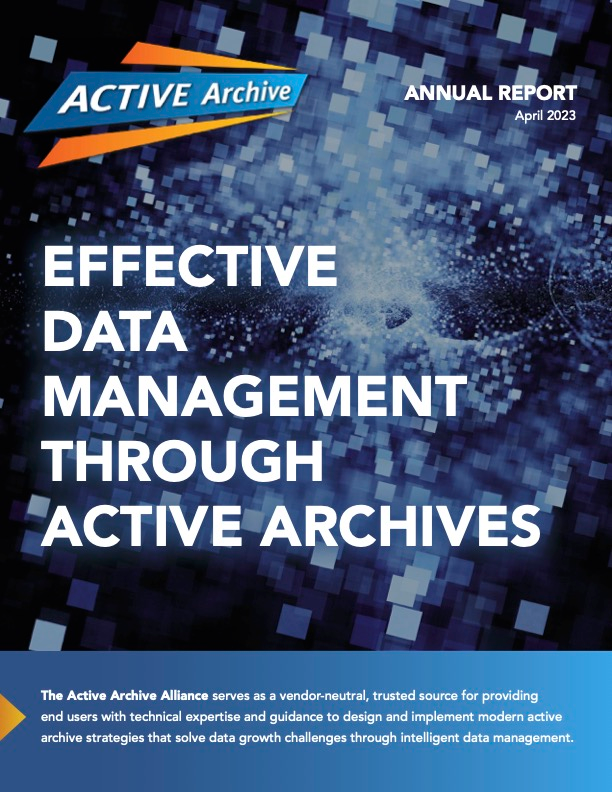An active archive is a storage system that provides immediate access to information, enabling long-term retention and preservation. Numerous industries are currently experiencing challenges when it comes to increasing data volume and active archive solutions have emerged as a way to address that issue in today's information-driven world. Overall, these solutions provide a scalable, secure, and affordable way to manage and protect data.
Active archiving employs a hierarchical system that includes high-performance SSD and HDD drives and tape-based systems. High-performance drives store frequently accessed information while less frequently accessed information is moved to tape-based systems. This cost-effective and scalable solution minimizes reliance on expensive SSD and HDD drives while also supporting long-term data preservation and accessibility, eliminating the need for frequent migration. Active archive solutions are a secure and sustainable option for organizations seeking to manage their information growth effectively and efficiently.

Archival storage solutions provide many benefits that can help enterprises meet their storage and preservation requirements efficiently. Active archives specifically provide readily accessible, high-capacity storage with increased data security and protection. The cost-effective advantages also reduce reliance on expensive primary storage. By implementing an appropriate solution, large organizations can effectively handle their growth, ensure availability and accessibility, and reduce storage expenses.
Moving unchanged files to an active archive can drastically reduce data backup and recovery times. Most organizations waste a significant amount of time and resources on backup of inactive data, files that do not change for months or years. This practice has remained virtually unchanged for many years, despite the huge surge in data growth. Backup deduplication systems have reduced the storage space needed for backup and simplified management, but backup window times are still virtually the same.

In addition to providing an affordable solution for storing and managing massive amounts of data, active archives also maintain flexibility and innovation to help enterprises keep up with emerging trends and sustain their competitive advantage. In this section, we will explore how this storage solution can address some of the most pressing trends facing businesses today.
Active archives differ from traditional archives in that they are always online and easily accessible, allowing for faster retrieval and analysis. Traditional archives, on the other hand, are typically offline and can be time-consuming and labor-intensive to retrieve and load back into a primary system, limiting the data’s usefulness. Active archives also offer the features stated above, such as intelligent data management and storage tiers, making them more scalable and affordable than traditional archives, which lack advanced data management features and can be costly to maintain. Overall, active archives provide significant advantages over traditional archives by offering faster access to information and more advanced data management features without the need for IT personnel involvement.

While it is possible to have an active archive without automated tape libraries, it would not be as practical or cost-effective. The total cost of ownership (TCO) for tape is lower than other storage options, and tape storage provides a low-energy consumption profile, making it an ideal choice for long-term active archiving. In contrast, relying solely on hard drives or other devices would not be as affordable in the long run. While these devices may offer high performance, they also require more energy to operate and cool and may not be as reliable over time. Ultimately, tape is an important component of any storage strategy, allowing organizations to store large amounts of data in a cost-effective and energy-efficient manner.
The Active Archive Alliance (AAA) Annual Report provides valuable insights into managing relentless data growth challenges and emphasizes the benefits of active archiving as a modern data management strategy. This report highlights the issues enterprises face and the importance of intelligent data management to combat these issues.

Download the AAA 2023 Annual Report
Discover the power of an active archive and unlock the benefits of a data management strategy today. Contact FUJIFILM to learn more about how you can implement this solution as a modern and sustainable strategy for managing data growth.